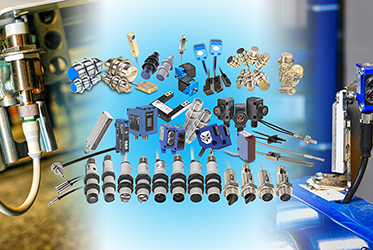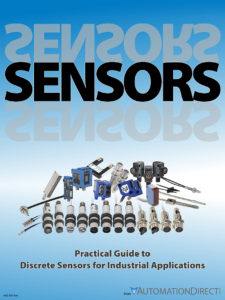
A practical guide for different types of discrete, object detection sensors
Mike Edwards
Features AutomationDirect sensors
There are many types of object detection sensors available on the market. Some of them, such as limit switches, require direct contact with the object.
Others, such as proximity sensors, need to be in close physical range but do not make contact with the object. Still others can detect objects from much further distances; examples include photoelectric, laser and ultrasonic sensors.
Limit Switches
Limit switches are one of the most common object detection sensors used in industrial controls. They are energized when an object makes physical contact with the actuator. They normally provide an electromechanical contact closure, but some also move a pneumatic valve. There are many different form factors and actuator styles to choose from.
Inductive Proximity Sensors
Inductive proximity sensors detect the presence of metallic objects at close range (under 1.5 in. typically). Ferrous metals allow the greatest distances to the sensor; other metals may reduce detection range.
Magnetic Proximity Sensors
Magnetic proximity sensors are used for non-contact object detection beyond the normal limits of inductive sensors. Used with a separate damping magnet, they offer very long sensing ranges in a small package and can detect magnets through walls of non-ferrous metal, stainless steel, aluminum, plastic or wood.
 Capacitive Proximity Sensors
Capacitive Proximity Sensors
Capacitive proximity sensors use a dielectric plate generating an electrostatic field to detect both metal and non-metal objects and can sense through insulating materials such as wood or plastic. They are often used to detect fill levels of liquids, pellets, and powders through container walls. Capacitive sensors are available in cylindrical or rectangular shapes, with sensing distances typically up to 40 mm.
Photoelectric Sensors
Photoelectric sensors use reflected or detected light waves to detect object presence or distance in a wide range of industrial applications. They typically contain all required optics and electronics in a single unit, requiring only power to provide an output based on their specifications and object detection criteria.
Photoelectric sensors can detect a wide variety of materials and have extended sensing ranges.
Specialty Sensors
Other object detection sensors are available for specialized applications. Some specialty sensors available that work similarly to a photoelectric sensor are laser sensors, fibre optic sensors, fork sensors, and area sensors.
This is an excerpt from the primer SENSORS: Practical Guide to Discrete Sensors for Industrial Applications published by AutomationDirect. Click here to download.
Print this page